germans
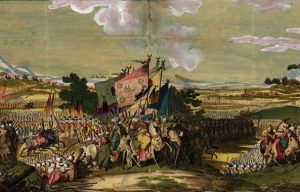 Through the years, people have been known to self destruct. Suicide is, unfortunately, not that uncommon, but this is not a story of suicide, spontaneous combustion, or accidental overdose. It is rather a story of an Army that “self destructed.” An entire army, although, some of them might have survived the “attack.” The insanity happened during the Austro-Turkish (Hapsburg-Ottoman) War, which lasted from 1787 to 1791, and occurred at almost the same time as the Russo-Turkish War was being fought, in which the Austrians were allies of Russia to fight a common foe. The Austrian (or Hapsburg Empire) Army at that time was composed of Austrians, Czechs, Germans, French, Serbs, Croats, and Polish, effectively making communication difficult, and a similar communications issue as the Tower of Babel, as possible. Most of the facts about the Austro-Turkish War were not written until 1831, when they were compiled in the Austrian Military Magazine. Another source was the German account by A. J. Gross-Hoffinger in Geschichte Josephs des Zweiten, which was itself not compiled until around 60 years later. Yet another, albeit less popular source, was the 1843 account of the war in “History of the Eighteenth Century and of the Nineteenth till the Overthrow of the French Empire, with particular reference to mental cultivation and progress.”
Through the years, people have been known to self destruct. Suicide is, unfortunately, not that uncommon, but this is not a story of suicide, spontaneous combustion, or accidental overdose. It is rather a story of an Army that “self destructed.” An entire army, although, some of them might have survived the “attack.” The insanity happened during the Austro-Turkish (Hapsburg-Ottoman) War, which lasted from 1787 to 1791, and occurred at almost the same time as the Russo-Turkish War was being fought, in which the Austrians were allies of Russia to fight a common foe. The Austrian (or Hapsburg Empire) Army at that time was composed of Austrians, Czechs, Germans, French, Serbs, Croats, and Polish, effectively making communication difficult, and a similar communications issue as the Tower of Babel, as possible. Most of the facts about the Austro-Turkish War were not written until 1831, when they were compiled in the Austrian Military Magazine. Another source was the German account by A. J. Gross-Hoffinger in Geschichte Josephs des Zweiten, which was itself not compiled until around 60 years later. Yet another, albeit less popular source, was the 1843 account of the war in “History of the Eighteenth Century and of the Nineteenth till the Overthrow of the French Empire, with particular reference to mental cultivation and progress.”
The “Battle of Karansebes,” apparently took place in the town of Karansebes, in present day Romania, on September 17th, 1788. Austria at that time was fighting with Turkey for control of the Danube River. The battle started with a number of Austrian cavalrymen soldiers on a night patrol. Looking for Turkish soldiers in the area where the Austrian Army had set up camp earlier that day, the Austrian Army night patrol chanced upon some Gypsies across the river. The Gypsies offered them Schnapps to relieve the war-weary soldiers. Seeing a chance to relax before the next day’s battle, the soldiers began drinking…their first mistake. Later, a contingent of Austrian infantry men found the cavalrymen having a party and wanted to join in. However, the cavalrymen refused them the alcohol…their second mistake, and the one that started a quarrel that turned into a fistfight. The next thing anybody knew, a shot was fired across the river. Some infantrymen in the distance shouted, “Turks, Turks,” mistaking the gunshot as coming from the enemy Ottoman Turks. Both parties, Austrian infantrymen and Austrian cavalrymen alike, fled back to the other side of the river where they camped, but by that time, chaos and disorder had taken over. Some soldiers were fleeing due to unpreparedness, while some German officers shouted, “Halt! Halt!.” Non-German soldiers not understanding the German language, and thought it meant “Allah”, referring to the Islamic Turkish making cries unto their God. This prompted the majority of the Austrian Army to start shooting at each other. Everyone commenced shooting at fellow Austrian and even shadows, thinking the enemy was upon them. Soon, an Austrian corps commander, thinking that a cavalry attack from the Turkish Army was in progress, ordered artillery fire on his own men!
The casualties were enormous, and amounted to about 10,000 Austrian soldiers dead and wounded. The Turkish Army arrived two days later, and found the town of Karansebes without defense. The Turkish Army took over the town easily soon after their arrival. Although many people attest that the battle really happened, some argue over its authenticity, due to the fact that no record of it was written until some 40 years later. Some argue that embarrassment may be the cause why no accounts of the incident were published until several decades later. Others say that the Austrian Army during that time was led by Austrian and German officers, while the infantrymen were composed of other European nation allies. In that regard, for some Austrians at least, if the battle fought was won, the victory was Austrian, but if they lost the battle, the blame was on the non-Austrian soldiers who had been forced into service.
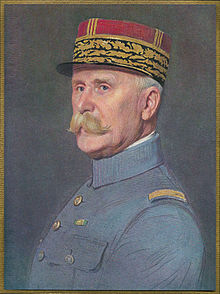
 Sometimes, when a war plane is in danger of being captured by the enemy, the pilot might take measures to destroy it, so that the technological secrets don’t end up in enemy hands. In fact, I believe that these days, anytime a plane goes down in enemy territory, the pilots are told to destroy them, but I’m not sure on that.
Sometimes, when a war plane is in danger of being captured by the enemy, the pilot might take measures to destroy it, so that the technological secrets don’t end up in enemy hands. In fact, I believe that these days, anytime a plane goes down in enemy territory, the pilots are told to destroy them, but I’m not sure on that.
Strange as that may seem to most of us, on November 27, 1942, something even more strange happened, but I’m getting ahead of myself. In June of 1940, after the German invasion of France and the establishment of an unoccupied zone in the southeast, which was led by General Philippe Petain, Admiral Jean Darlan was committed to keeping the French fleet out of German control. At the same time, as a minister in the government that had signed an armistice with the Germans, one that promised a relative “autonomy” to Vichy France, Darlan was prohibited from sailing that fleet to British or neutral waters. It put him in a rather precarious position, to say the least.
The British were as concerned as the French. A German-commandeered fleet in southern France, so close to British-controlled regions in North Africa, could prove disastrous to the British, who decided to take matters into their own hands by launching Operation Catapult…the attempt by a British naval force to persuade the French naval commander at Oran to either break the armistice and sail the French fleet out of the Germans’ grasp…or to scuttle it. And if the French wouldn’t, the Brits would. If you’ve ever heard the expression, “between a rock and a hard place,” you can picture this situation. And the British tried to push their way in it. In a five-minute missile bombardment, they managed to sink one French cruiser and two old battleships. They also killed 1,250 French sailors. This would be the source of much bad blood between France and England throughout the war. General Petain broke off diplomatic relations with Great Britain.
Two years later, the situation had worsened, with the Germans now in Vichy and the armistice already violated. Admiral Jean de Laborde finished the job the British had started. Just as the Germans launched Operation Lila…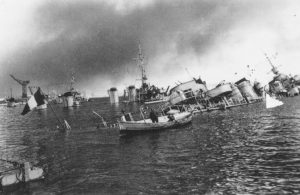
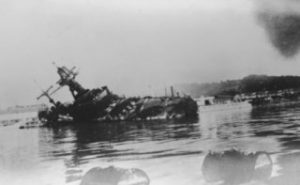 the attempt to commandeer the French fleet, at Toulon harbor, off the southern coast of France, Laborde ordered the sinking of 2 battle cruisers, 4 heavy cruisers, 2 light cruisers, 1 aircraft transport, 30 destroyers, and 16 submarines. Three French subs managed to escape the Germans and make it to Algiers, Allied territory. Only one sub fell into German hands. The marine equivalent of a scorched-earth policy had succeeded.
the attempt to commandeer the French fleet, at Toulon harbor, off the southern coast of France, Laborde ordered the sinking of 2 battle cruisers, 4 heavy cruisers, 2 light cruisers, 1 aircraft transport, 30 destroyers, and 16 submarines. Three French subs managed to escape the Germans and make it to Algiers, Allied territory. Only one sub fell into German hands. The marine equivalent of a scorched-earth policy had succeeded.
 During World War II, the Germans began a bombing campaign, during the Battle for Britain, that was known as the Blitzkrieg, which means lightning war. The name was often shortened to the Blitz. The Blitz began on September 7, 1940 and would continue until May 1941. During these bombing raids, London was especially badly hit. At the start of the campaign, the government did not allow the use of underground rail stations as shelters, as they considered them a potential safety hazard. However, the people of London took the matter into their own hands and opened up the chained entrances to the tube stations. In the Underground they were safe from the high explosive and incendiary bombs that rained down on London night after night. With one or two exceptions, their confidence was rewarded. The City tube station was hit when a bomb went through the road and fell into it. Over 200 were killed, but for the most part the tubes proved to be good bomb shelters.
During World War II, the Germans began a bombing campaign, during the Battle for Britain, that was known as the Blitzkrieg, which means lightning war. The name was often shortened to the Blitz. The Blitz began on September 7, 1940 and would continue until May 1941. During these bombing raids, London was especially badly hit. At the start of the campaign, the government did not allow the use of underground rail stations as shelters, as they considered them a potential safety hazard. However, the people of London took the matter into their own hands and opened up the chained entrances to the tube stations. In the Underground they were safe from the high explosive and incendiary bombs that rained down on London night after night. With one or two exceptions, their confidence was rewarded. The City tube station was hit when a bomb went through the road and fell into it. Over 200 were killed, but for the most part the tubes proved to be good bomb shelters.
One eyewitness to the tube shelters said, “By 4.00 p.m. all the platforms and passage space of the underground station are staked out, chiefly with blankets folded in long strips laid against the wall – for the trains are still running and the platforms in use. A woman or child guards places for about six people. When the evening comes the rest of the family crowd in.” To start with the government underestimated the potential use of the underground stations. The government estimated that 87% or more of people would use the issued shelters…usually Anderson shelters…or spaces under stairs, and such. They assumed that only 4% of the population would use the underground stations. However, each night underground stations played host to thousands of families in London grateful for the protection they afforded. On November 8, 1940, a request  went out for blankets to aid the people sleeping in these underground tunnels. Times were hard in many areas of the London, and many Londoners spent their winter nights in the underground tunnels and shelters. Supplies of any new or old blankets that could be spared were called for in order to provide additional warmth for these people.
went out for blankets to aid the people sleeping in these underground tunnels. Times were hard in many areas of the London, and many Londoners spent their winter nights in the underground tunnels and shelters. Supplies of any new or old blankets that could be spared were called for in order to provide additional warmth for these people.
London went into mandatory blackouts every night to try to be invisible to the bombers. Despite the blackout restrictions, the Luftwaffe had a relatively easy way of getting to London. They simply followed the route of the River Thames, which also directed them to the docks based at the East End of the city. Each night, the bombers first dropped incendiary bombs designed to give the following bombers the most obvious of markers. After the incendiary bombs, came the high explosives. The government used its control over all forms of the media to present a picture of life going on as normal despite the constant nightly attacks. I suppose some would call this fake news, but it was the governments way of making it look like the Germans weren’t making any headway. They did not show photos of people known as trekkers, the families who would spend the night away from their homes, preferably in local woodland or a park where they felt safer from attack. Such photos were censored. An American film called “London can take it” presented the image of a city devastated by bombs, but one that carried on as normal. The narrator makes the point that “bombs can only kill people, they cannot destroy the indomitable spirit of a nation.”
However, we know that in reality, life was not quite as easy as propaganda showed. Indeed, London could take it, but only because there was little else they could do. Under wartime restrictions, people could not simply 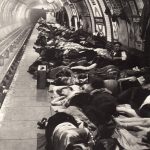 leave their homes and move elsewhere. The poorest in London lived in the East End, and it was this area that was especially hit hard by bombing because of the docks that were based there. However, most of the families there could do little else except stay where they were unless specifically moved by the government. These families developed what became known as a war-time spirit. They adapted their lives to the constant night-time bombing. By May 1941, 43,000 had been killed across Britain and 1.4 million had been made homeless. Not only was London attacked, but so were many British cities. Coventry and Plymouth were particularly badly bombed but most of Britain’s cities were also attacked, including Manchester, Glasgow, and Liverpool. Nevertheless, they were not broken.
leave their homes and move elsewhere. The poorest in London lived in the East End, and it was this area that was especially hit hard by bombing because of the docks that were based there. However, most of the families there could do little else except stay where they were unless specifically moved by the government. These families developed what became known as a war-time spirit. They adapted their lives to the constant night-time bombing. By May 1941, 43,000 had been killed across Britain and 1.4 million had been made homeless. Not only was London attacked, but so were many British cities. Coventry and Plymouth were particularly badly bombed but most of Britain’s cities were also attacked, including Manchester, Glasgow, and Liverpool. Nevertheless, they were not broken.
 When we think of Nazi Germany, Hitler always comes to mind. We all know that he was an insane, murderous dictator, and that the people of Germany were afraid to stand up to him and his army. We know that he hated the Jewish people, even though he was part Jewish, and that later he also hated the gypsies. His hatred grew so strong that he enslaved and killed many thousands of these people, for no crime other than that they were Jewish or gypsies. During the years of Hitler’s reign, there were those who followed him because they agreed with him, those who just weren’t sure what they believed, and those who disagreed, but dared not oppose him. Children were often taken from their families and raised to be good Nazis. I’m sure this added to the number of people who agreed with Hitler, because it is a well know fact that children learn what they live.
When we think of Nazi Germany, Hitler always comes to mind. We all know that he was an insane, murderous dictator, and that the people of Germany were afraid to stand up to him and his army. We know that he hated the Jewish people, even though he was part Jewish, and that later he also hated the gypsies. His hatred grew so strong that he enslaved and killed many thousands of these people, for no crime other than that they were Jewish or gypsies. During the years of Hitler’s reign, there were those who followed him because they agreed with him, those who just weren’t sure what they believed, and those who disagreed, but dared not oppose him. Children were often taken from their families and raised to be good Nazis. I’m sure this added to the number of people who agreed with Hitler, because it is a well know fact that children learn what they live.
Nevertheless, while many people think that all the German people agreed with Hitler’s ways, but in reality, that was not the case. As World War II started to turn against the Germans, and Hitler’s atrocities grew, growing numbers of Germans, both military and civilian…began conspiring to assassinate their leader. It was assumed that the masses were unlikely to turn on the man in whose hands they had placed their lives and future. That said, they knew that it was up to men close to Hitler…German officers, to remove him. Leadership of the plot fell to Claus von Stauffenberg, newly promoted to colonel and chief of staff to the commander of the army reserve. His position gave him access to Hitler’s headquarters at Berchtesgaden and Rustenburg.
Stauffenberg had served in the German army since 1926. He was a staff officer in the campaign against the Soviet Union. He became disgusted at his fellow countrymen’s vicious treatment of Jews and Soviet prisoners. He requested to be transferred to North Africa, where he lost his left eye, right hand, and two fingers of his left hand. After recovering from his injuries, Stauffenberg became determined to see Hitler removed from power by 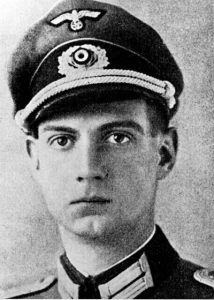 any means necessary. He traveled to Berchtesgaden on July 3 and met with a fellow army officer, Major General Helmuth Stieff, who gave him a bomb with a silent fuse that was small enough to be hidden in a briefcase. On July 11, 1944, Stauffenberg was summoned to Berchtesgaden to report to Hitler on the current military situation. He planned to use the bomb on July 15, but at the last minute, Hitler was called away to his headquarters at Rustenburg, in East Prussia. Stauffenberg was asked to follow him there. On July 16, a meeting took place between Stauffenberg and Colonel Caesar von Hofacker, who was another conspirator, in the Berlin suburb of Wannsee. Hofacker informed Stauffenberg that German defenses had collapsed at Normandy, and the tide had turned against them in the West. The assassination attempt was postponed until July 20, at Rustenburg. In the end, it wasn’t an assassin’s bomb that ended Hitler’s reign, but rather his own hands. Nevertheless, it wasn’t because the German people wanted him to continue to be their leader, because they definitely did not.
any means necessary. He traveled to Berchtesgaden on July 3 and met with a fellow army officer, Major General Helmuth Stieff, who gave him a bomb with a silent fuse that was small enough to be hidden in a briefcase. On July 11, 1944, Stauffenberg was summoned to Berchtesgaden to report to Hitler on the current military situation. He planned to use the bomb on July 15, but at the last minute, Hitler was called away to his headquarters at Rustenburg, in East Prussia. Stauffenberg was asked to follow him there. On July 16, a meeting took place between Stauffenberg and Colonel Caesar von Hofacker, who was another conspirator, in the Berlin suburb of Wannsee. Hofacker informed Stauffenberg that German defenses had collapsed at Normandy, and the tide had turned against them in the West. The assassination attempt was postponed until July 20, at Rustenburg. In the end, it wasn’t an assassin’s bomb that ended Hitler’s reign, but rather his own hands. Nevertheless, it wasn’t because the German people wanted him to continue to be their leader, because they definitely did not.
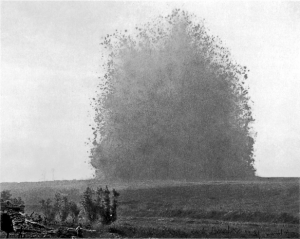 The manner in which battles are fought and won, never ceases to amaze me. In 1916, British forces began planning the Battle of Messines Ridge. For 18 months, soldiers worked to place nearly 1 million pounds of explosives in tunnels under the German positions. The tunnels extended to some 2,000 feet in length, and some were as much as 100 feet below the surface of the ridge, where the Germans had long since been entrenched. The Germans had no idea that they were there, and no idea what was going to happen. I find myself in complete amazement, that all those soldiers were working a mere 100 feet below ground, and the German soldiers above them had no idea. It was the element of surprise that was the whole key to this successful attack.
The manner in which battles are fought and won, never ceases to amaze me. In 1916, British forces began planning the Battle of Messines Ridge. For 18 months, soldiers worked to place nearly 1 million pounds of explosives in tunnels under the German positions. The tunnels extended to some 2,000 feet in length, and some were as much as 100 feet below the surface of the ridge, where the Germans had long since been entrenched. The Germans had no idea that they were there, and no idea what was going to happen. I find myself in complete amazement, that all those soldiers were working a mere 100 feet below ground, and the German soldiers above them had no idea. It was the element of surprise that was the whole key to this successful attack.
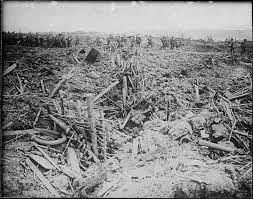 At 3:10am on June 7, 1917, a series of simultaneous explosions rocked the area. The explosions were heard as far away as London. A German observer described the explosions saying, “nineteen gigantic roses with carmine petals, or enormous mushrooms, rose up slowly and majestically out of the ground and then split into pieces with a mighty roar, sending up multi-colored columns of flame mixed with a mass of earth and splinters high in the sky.” While Messines Ridge itself was considered a relatively limited victory, it had a considerable effect. German losses that day included more than 10,000 men who died instantly, along with some 7,000 prisoners…men who were too stunned and disoriented by the explosions to resist the infantry assault.
At 3:10am on June 7, 1917, a series of simultaneous explosions rocked the area. The explosions were heard as far away as London. A German observer described the explosions saying, “nineteen gigantic roses with carmine petals, or enormous mushrooms, rose up slowly and majestically out of the ground and then split into pieces with a mighty roar, sending up multi-colored columns of flame mixed with a mass of earth and splinters high in the sky.” While Messines Ridge itself was considered a relatively limited victory, it had a considerable effect. German losses that day included more than 10,000 men who died instantly, along with some 7,000 prisoners…men who were too stunned and disoriented by the explosions to resist the infantry assault.
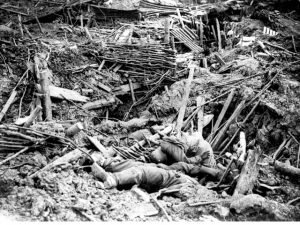
It was a crushing victory over the Germans. The German army was forced to retreat to the east. This retreat and the sacrifice that it entailed marked the beginning of their gradual, but continuous loss of territory along the Western Front. It also secured the right flank of the British army’s push towards the much-contested Ypres region, which was the eventual objective of the planned attack. Over the next month and a half, British forces continued to push the Germans back toward the high ridge at Passchendaele. Then on July 31 the British army launched it’s offensive, known as the Battle of Passchendaele or the Third Battle of Ypres.
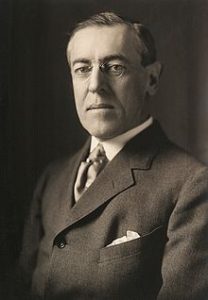 Desperate times call for desperate measures…and sometimes, they call for pleading. On March 23, 1918, two days after the launch of a major German offensive in northern France, British Prime Minister David Lloyd George telegraphed the British ambassador in Washington, Lord Reading, urging him to explain to United States President Woodrow Wilson that without help from the US, “we cannot keep our divisions supplied for more than a short time at the present rate of loss. This situation is undoubtedly critical and if America delays now she may be too late.” Of course, nothing happens quickly in government, but this was a different thing. In response, President Wilson agreed to send a direct order to the commander in chief of the American Expeditionary Force, General John J. Pershing, telling him that American troops already in France should join British and French divisions immediately, without waiting for enough soldiers to arrive to form brigades of their own. Pershing agreed to this on April 2, providing a boost in morale for the exhausted Allies.
Desperate times call for desperate measures…and sometimes, they call for pleading. On March 23, 1918, two days after the launch of a major German offensive in northern France, British Prime Minister David Lloyd George telegraphed the British ambassador in Washington, Lord Reading, urging him to explain to United States President Woodrow Wilson that without help from the US, “we cannot keep our divisions supplied for more than a short time at the present rate of loss. This situation is undoubtedly critical and if America delays now she may be too late.” Of course, nothing happens quickly in government, but this was a different thing. In response, President Wilson agreed to send a direct order to the commander in chief of the American Expeditionary Force, General John J. Pershing, telling him that American troops already in France should join British and French divisions immediately, without waiting for enough soldiers to arrive to form brigades of their own. Pershing agreed to this on April 2, providing a boost in morale for the exhausted Allies.
The non-stop German offensive continued to take its toll throughout the month of April, however, because the majority of American troops in Europe, who were now arriving at a rate of 120,000 a month, were still not sent into battle. In a meeting of the Supreme War Council of Allied leaders at Abbeville, near the coast of the English Channel, which began on May 1, 1918, Clemenceau, Lloyd George and General Ferdinand Foch, the recently named Generalissimo of all Allied forces on the Western Front, was trying hard to persuade Pershing to send all the existing American troops to the front at once. Pershing resisted, reminding the group that the United States had entered the war “independently” of the other Allies, and indeed, the United States would insist during and after the war on being known as an “associate” rather than a full-fledged ally. He further stated, “I do not suppose that the American army is to be entirely at the disposal of the French and British commands.” I’m sure his remarks brought with them, much concern.
On May 2, the second day of the meeting, the debate continued, with Pershing holding his ground in the face of  heated appeals by the other leaders. He proposed a compromise, which in the end Lloyd George and Clemenceau had no choice but to accept. Pershing proposed that the United States would send the 130,000 troops arriving in May, as well as another 150,000 in June, to join the Allied front line. He would not make provision for July. This agreement meant that of the 650,000 American troops in Europe by the end of May 1918, roughly one third would go to battle that summer. The other two thirds would not go to the front until they were organized, trained and ready to fight as a purely American army, which Pershing estimated would not happen until the late spring of 1919. I’m sure Pershing’s concern was poorly trained soldiers fighting with little chance of winning. Still, by the time the war ended on November 11, 1918, more than 2 million American soldiers had served on the battlefields of Western Europe, and some 50,000 of them had lost their lives. The United States did go into battle and help win that war, but many thought that the delays cost lives.
heated appeals by the other leaders. He proposed a compromise, which in the end Lloyd George and Clemenceau had no choice but to accept. Pershing proposed that the United States would send the 130,000 troops arriving in May, as well as another 150,000 in June, to join the Allied front line. He would not make provision for July. This agreement meant that of the 650,000 American troops in Europe by the end of May 1918, roughly one third would go to battle that summer. The other two thirds would not go to the front until they were organized, trained and ready to fight as a purely American army, which Pershing estimated would not happen until the late spring of 1919. I’m sure Pershing’s concern was poorly trained soldiers fighting with little chance of winning. Still, by the time the war ended on November 11, 1918, more than 2 million American soldiers had served on the battlefields of Western Europe, and some 50,000 of them had lost their lives. The United States did go into battle and help win that war, but many thought that the delays cost lives.
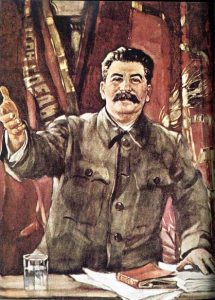 Imagine being in a country where being afraid is a crime. I’m sure you are wondering how that is possible…in any country, but I assure you, it is. That was the case on this day, July 27, 1943 in Russia. Joseph Stalin was the premier and dictator of Russia at that time in history, and Adolf Hitler was the dictator of Germany. The Germans were advancing into Russian territory, and Stalin was determined to stop them, no matter the cost.
Imagine being in a country where being afraid is a crime. I’m sure you are wondering how that is possible…in any country, but I assure you, it is. That was the case on this day, July 27, 1943 in Russia. Joseph Stalin was the premier and dictator of Russia at that time in history, and Adolf Hitler was the dictator of Germany. The Germans were advancing into Russian territory, and Stalin was determined to stop them, no matter the cost.
Hitler had become quite bold because of the early successes against Russia in his goal of taking Leningrad and Stalingrad. The attack on Stalingrad proved, however, that the Russians had superior manpower and it was an enormous drain on German resources and troop strength. The Germans were repulsed by a fierce Soviet fighting force, that had been reinforced with more men and materials. Hitler made the decision to turn his sights to Leningrad.
Stalin needed to make sure his force wouldn’t back down…no matter what happened. The motivation to stand 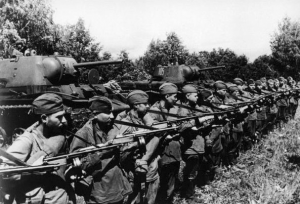 their ground needed to apply to both officers and civilians alike, or he was sure that Leningrad would be lost. That was when Stalin decided to put order number 227 into effect. So, what was order number 227? The order declared, “Panic makers and cowards must be liquidated on the spot. Not one step backward without orders from higher headquarters! Commanders…who abandon a position without an order from higher headquarters are traitors to the Fatherland.” Basically the order said that no one…not one person would be a coward. The order became known as the “not one step backward” order. The military personnel, as well as civilians were forced to fight for their city.
their ground needed to apply to both officers and civilians alike, or he was sure that Leningrad would be lost. That was when Stalin decided to put order number 227 into effect. So, what was order number 227? The order declared, “Panic makers and cowards must be liquidated on the spot. Not one step backward without orders from higher headquarters! Commanders…who abandon a position without an order from higher headquarters are traitors to the Fatherland.” Basically the order said that no one…not one person would be a coward. The order became known as the “not one step backward” order. The military personnel, as well as civilians were forced to fight for their city.
I think I can understand what Stalin was doing, but it seems such a drastic measure to take. Still, while some  people might fight the enemy to the end, others might decide that their city wasn’t worth their life. If the penalty for backing off was instant liquidation, then standing and fighting became the only way to have a chance at life. In my opinion, that as far as ways to gain loyalty goes, this was not the best of plans, but then forced loyalty seldom is. Still, one must never underestimate the love a patriot feels for their country. The “not one step backward” order was virtually unnecessary, in that on the day the order was issued, the Russian peasants and other supporters in the Leningrad region killed a German official, Adolf Beck, whose job was to send agricultural products from occupied Russia to Germany and to German troops. The Russian patriots also set fire to the granaries and barns in which the stash of agricultural products was stored before transport. A partisan pamphlet issued an order of its own: “Russians! Destroy the German landowners. Drive the Germans from the land of the Soviets!” I guess Stalin had misjudged his peoples’ loyalty.
people might fight the enemy to the end, others might decide that their city wasn’t worth their life. If the penalty for backing off was instant liquidation, then standing and fighting became the only way to have a chance at life. In my opinion, that as far as ways to gain loyalty goes, this was not the best of plans, but then forced loyalty seldom is. Still, one must never underestimate the love a patriot feels for their country. The “not one step backward” order was virtually unnecessary, in that on the day the order was issued, the Russian peasants and other supporters in the Leningrad region killed a German official, Adolf Beck, whose job was to send agricultural products from occupied Russia to Germany and to German troops. The Russian patriots also set fire to the granaries and barns in which the stash of agricultural products was stored before transport. A partisan pamphlet issued an order of its own: “Russians! Destroy the German landowners. Drive the Germans from the land of the Soviets!” I guess Stalin had misjudged his peoples’ loyalty.

